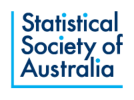The Early Career Statisticians and Students Conference (ECSSC) kicked off a full week of keynote speakers, panel discussions, abstract and poster presentations, and social events on the 26th of July, 2021. The event, previously known as the Young Statisticians Conference, is a forum designed to connect statisticians who are in the early stages of their careers. This year it was entirely virtual for the first time.
Delegates were treated to talks on a wide range of topics covering innovative academic research, solutions developed for industry, and tips for navigating the rigors of study and life on the job.
Keynote speakers with a wealth of experience in their respective fields generously shared their work and wisdom. Peter Taylor of the University of Melbourne discussed modelling the Bitcoin Blockchain. Minh-Ngoc Tran of the University of Sydney made the case for Variational Bayes. Kendra Vant took us through the machine learning techniques she uses to create products at Xero. Paola Oliva-Altamirano shared the lessons she and her team at Innovations Lab (Our Community/ SmartyGrants) have learned in creating text classifiers for machine learning models. And finally, Helena Jia presented an inside look into the complex world of educational survey assessment design and analysis.
Talent and enthusiasm were on full display during the delegate presentations. The line-up of fascinating and conversation-provoking talks provided tough competition for the Louise Ryan award for best oral presentation. Elena Tartaglia ultimately secured first prize for her talk “Understanding the role of causal inference from observational datasets in developing government policy”. Second prize went to Sharm Thuraisingam for “Surviving a PhD with a toddler during a pandemic” and third to John Warmenhoven for “A non-conventional entry into the world of statistics.”
The newly created Alison Harcourt award for best poster went to Josh Jacobson. Puxue Qiao snared second place and Vanessa Pac Soo was awarded third. Parinaz Mehdipour won the Sue Finch Data Visualisation award for the presentation of data in her talk “Bayesian Within-host Modelling of Red Blood Cell Dynamics and Primaquine-induced Haemolysis in G6PD Deficiency”.
Shawn Lew Wei Hwa won the video competition for his presentation of “Project Guide Me”, an analysis of how well the visually impaired have been able to integrate into Singaporean society.
Despite the virtual setting, there was an abundance of opportunities to connect with other attendees and perhaps even win some prizes. The virtual pub was open for casual chats at the close of the last presentation each day. Delegates networked in breakout rooms, competed in trivia games, and even watched a movie together.
The youngest generation of future statisticians took centre stage during the high school engagement day. Participants got a rundown of the basics of R during an introductory workshop. They heard about the exploits of statisticians working at the ABS, Data61 and NSW Health, and got the chance to win books about statistics and other prizes.
Throughout the conference, there were also panel discussions, information sessions from our sponsors, and a conversation about how the SSA and the ECSSN could better meet the needs of members. All the while, delegates chatted in the slack channel, punctuating posts with an increasingly creative use of emojis.
An inspiring video interview with the incomparable Alison Harcourt concluded the event.
The ECSSC 2021 could not have been put together without the generous support of our sponsors: ABS, ASMI, ACEMS, BCA and Survey Design. Special thanks to the SSA, in particular Marie-Louise Rankin and Jodi Phillips, whose tireless efforts ensured the event’s success. Special thanks also to the keynote speakers, panelists, and delegates whose contributions motivated discussions, provided insight and encouraged connections and collaborations between members of the statistics community in Australia and beyond.
We look forward to seeing you at the next ECSSC!
Sherri McRae
ECSSC2021 Committee Member
